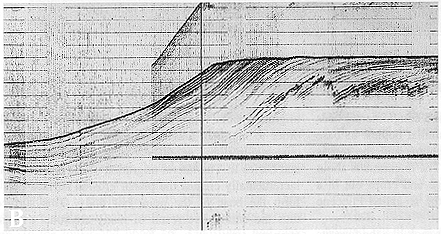

Clinostratification: prograding bodies
Plate 14


Clinostratification: prograding bodies
Plate 14
Clinostratification means primary inclination of bedding: the sediments were deposited on a sloping surface. This surface can dip in the direction of transport or across it; successive strata make a sedimentary body that grows frontally in the first case, laterally (transversally) in the second.
Frontal accretion is also called progradation, and creates dipping bedsets, made of shingling beds and called foresets. Foreset bedding can here be compared, at two different scales, in a wide outcrop of a gravel pit near Ancona (A) and a seismic section along the axis of the Adriatic Sea (B: south is to the left). For this growth model to occur, there must be an initial step, a difference in level between the point where the sediment is introduced and a deeper, horizontal bottom where gravity attracts it. This step migrates basinward by the more or less continuous addition of sediment. Deposition does not occur on its top, or is limited to thin sets of horizontal beds (topset ), because room is not or scarcely available there. A delta or a beach can advance into the sea in this way: sediment can be accommodated in front of them, below sea level, whereas vertical accretion is limited as it cannot occur above sea level. Aggradation is only possible, in coastal areas, when subsidence is active; room is then made by the sinking bottom, which is equivalent to a rising sea level, and sediment can compensate for it.
Foresets join tangentially the flat basinal deposits (see reflectors in B), also indicated as bottomset. In other cases, they make an angular contact (the already mentioned downlap). The landward connection with the topset can be either gradual (continuous deposition along the profile) or truncated by erosion; both cases are shown in the seismic profile, in the right and central parts, respectively. This upper contact is called toplap. Do not confuse topset and toplap: the former term indicates a mass, or volume of sediment, the latter one denotes a surface or, better, a contact between surfaces. All terms ending with "lap" are used for types of angular contacts, or uncon-formities; to those already quoted, add here offlap, which is simply the combination of down- and top-lap.
A: The gravel shown in the picture (see also details in plates 62 and 64) was brought to the Adriatic Sea in the Pleistocene by a torrential stream similar to those draining the Apennines today. The pebbles, with some sand, were redistributed by waves and littoral currents along the shore, forming gravel beaches that dipped into the sea at relatively high angles. Similar beaches can be presently observed along the Ionian coasts of southern Italy. The pebbles rolled down the beach face under the effect of gravity; they thus escaped the mechanical action of smaller, fair weather waves, being removed only by strong storm waves. Normal waves were more effective on the beach top (swash zone and berm), where they had time to wash, abrade, and sort the pebbles. Horizontal topset deposits are, in fact, made of smaller, better sorted and more rounded pebbles than foreset beds; moreover, flat pebbles are here retained by solid friction as they have a greater relative surface in comparison with spheroidal particles, more prone to rolling.
An even more impressive example of progradational body in outcrop is shown in color photo 2; it is a cross-section of a fan delta (a delta made of coarse clastics and leaning against a coastal relief), where foresets reach a thickness of several hundred meters.
B: During glacial epochs of the Quaternary, when land erosion was intensified and sea level lower, the Po delta advanced into the Adriatic Sea prolonging the alluvial plain into a mostly emerged shelf. The edge of this prograding shelf, now 140 m deep, is shown here, with the adjoining Mesoadriatic Depression, about 250 m deep. The youngest foreset deposits were truncated by wave and storm action when sea level rose and transgressed the shelf in Post-glacial times. Wave-reworked sediment formed thin topset deposits.
| Photo: M. Rainone 1980; inset: Institute for Marine Geology 1982. |